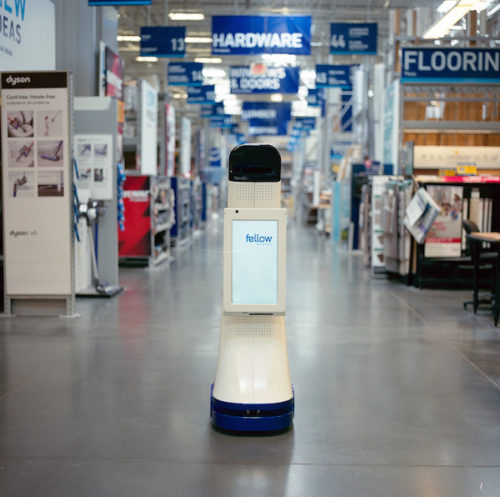
04/30/2017
Automation is creating a revolution in shopping: from ordering merchandise from Amazon to visiting a local supermarket with self-checkout, the machines are moving in. In particular, big changes are coming in retail out where the public will see them. Store sales persons who can advise and help customers are pretty much on the way out.Below, the LoweBot retail robot can guide customers to the location of items they want to purchase.

According to the Bureau of Labor Statistics, retail workers account for millions of jobs:
Retail salespersons and cashiers were occupations with highest employment in May 2015, March 31, 2016The upshot is that a large category of employment may be on the verge of disappearing, but Washington is tone deaf to technological changes to the jobs universe.Retail salespersons (4.6 million) and cashiers (3.5 million) were the occupations with the highest employment in May 2015. Combined, these two occupations made up nearly 6 percent of total U.S. employment. Annual mean wages were $26,340 for retail salespersons and $20,990 for cashiers. Office and administrative support was the largest occupational group, making up nearly 16 percent of total U.S. employment. Annual mean wages for workers in this group were $36,330.
The big picture of employment is indeed sobering. Oxford researchers forecast in 2013 that nearly half of American jobs were vulnerable to machine or software replacement within 20 years. Rice University computer scientist Moshe Vardi believes that in 30 years humans will become largely obsolete, and world joblessness will reach 50 percent. The Gartner tech advising company believes that one-third of jobs will be done by machines by 2025. Forrester Research Inc. has a more optimistic view, that there will be a net job loss of 7 percent by 2025 from automation. The recent PwC forecast was only slightly less severe than the Oxford numbers.
It therefore goes without saying that continued immigration of foreign workers is foolish and possibly dangerous. We wouldn’t want to see future unemployment riots carried out in Spanish.
In short:
Automation Makes Immigration Obsolete.
How will automation affect the retail industry?, CBS News, April 27, 2017Technology available today could automate 45 percent of the jobs people are paid to perform across all occupations. By the early 2030’s, 38 percent of current jobs in the U.S. could be automated and one industry could be hit particularly hard.
Since at least the industrial revolution, Americans have worried about technology taking their jobs. Past inventions have ended up creating new jobs, not just destroying old ones, but economists worry that this time may be different, reports Tony Dokoupil.
In Maplewood, New Jersey, Tim Jianni works the register of his family-owned convenience store — just as he has since high school.
“Here, we know all of our customers by name and I have papers or candies, I know what they get. I put it right there so that it is ready for them, and it makes them feel good,” Jianni said. “I just, you could see when they come in they have that smile on their face.”
One day, Jianni hopes to pass the job to a new generation, keeping it in the family or at least keeping it human.
Other retailers have a very different dream. For example, an autonomous, multilingual robot is designed to help customers at the home improvement chain, Lowe’s, to get their shopping done as quickly as possible.
“You can talk to it and it talks back to you,” said Kyle Nel, the executive director of Lowe’s innovation labs.
“It’s basically doing indoor mapping and figuring out where it is. Where you are,” Nel explained. “It will actually help you find the thing you’re looking for.”
The machine is one of 22 that the company is proudly testing in Northern California.
“Oh my gosh, there is an autonomous robot inside of a Lowe’s, awesome,” Nel said.
But what may look “awesome” for Lowe’s and many of the nation’s other businesses could spell anxiety for American workers.
For decades, automation has eaten up more American jobs than global trade, according to economists, who warn that the job losses may be poised to accelerate.
“I don’t think we’ve begun to grapple what that would mean for the economy if these jobs start to really go away in vast numbers,” said LinkedIn managing editor Chip Cutter.
Cutter, who has been studying automation, says cashiers and retail workers may be the hit hardest and comprise the single biggest job category in America.
When asked by Dokoupil whether these jobs could go away in the next two decades, Cutter responded, “That’s the fear.’
At a Stop and Shop in Bayonne, New Jersey, customers can be their own cashiers — scanning, bagging and swiping their credit cards.
Customer Kelsey O’Donnell says she recommends scanners to others, “This is a lot easier to get out the store a little quicker,” O’Donnell said.
At an Amazon concept store in Seattle, sensors allow customers to shop, walk out and pay via a wireless account.
“That’s the technology that a lot of people say may more resemble the future that we are gonna see,” Cutter said.
But many of the cashiers and retail workers of the world aren’t buying it. They think the robot revolution is overblown.
“A robot is just, they are not going to give you that personal interaction,” Jianni said. “That’s what people want.”
Judy Rubashkin works down the street at Words bookstore.
“People still like to talk to somebody. I don’t think you can replicate that,” Rubashkin said.
While Nel is excited about the future of their robot — or “Lowebot” — he says the store has no plans to replace human workers.
“Honestly and truly the robots are just a support system,” Nel said.
This is a content archive of VDARE.com, which Letitia James forced off of the Internet using lawfare.